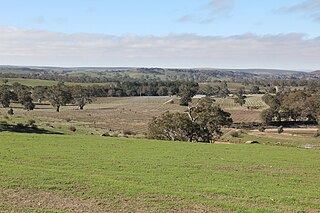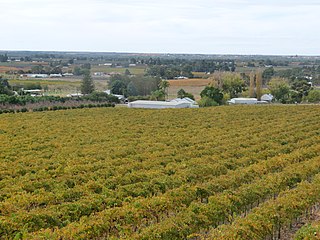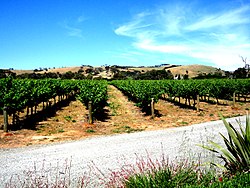
McLaren Vale is a wine region in the Australian state of South Australia located in the Adelaide metropolitan area and centred on the town of McLaren Vale about 38 kilometres (24 mi) south of the Adelaide city centre. It is internationally renowned for the wines it produces and is included within the Great Wine Capitals of the World. The region was named after either David McLaren, the Colonial Manager of the South Australia Company or John McLaren (unrelated) who surveyed the area in 1839. Among the first settlers to the region in late 1839, were two English farmers from Devon, William Colton and Charles Thomas Hewett. William Colton established the Daringa Farm and Charles Thomas Hewett established Oxenberry Farm. Both men would be prominent in the early days of McLaren Vale. Although initially the region's main economic activity was the growing of cereal crops, John Reynell and Thomas Hardy planted grape vines in 1838 and the present-day Seaview and Hardy wineries were in operation as early as 1850. Grapes were first planted in the region in 1838 and some vines more than 100 years old are still producing. Today there are more than 95 cellar doors in McLaren Vale. The majority are family-run operations and boutique wineries.

Alexandrina Council is a local government area in the Fleurieu and Kangaroo Island region of South Australia. The Alexandrina Council was formed on 1 July 1997 by the amalgamation of the District Council of Port Elliot and Goolwa, the District Council of Strathalbyn and a portion of the District Council of Willunga. The council is divided into five wards: Nangkita Kuitpo, Angas Bremer, Port Elliot Middleton, Strathalbyn and Goolwa Hindmarsh Island.

The Australian wine industry is one of the world's largest exporters of wine, with approximately 800 million out of the 1.2 to 1.3 billion litres produced annually exported to overseas markets. The wine industry is a significant contributor to the Australian economy through production, employment, export, and tourism.
Langhorne Creek is a town in South Australia, located approximately 55 kilometres from the Adelaide city centre. At the 2021 census, Langhorne Creek had a population of 444 residents.

The South Australian wine industry is responsible for more than half the production of all Australian wine. South Australia has a vast diversity in geography and climate which allows the state to be able to produce a range of grape varieties–from the cool climate Riesling variety in the Clare Valley wine region to the big, full bodied Shiraz wines of the Barossa Valley.
Tintara is an Australian winery located in McLaren Vale, South Australia within the McLaren Vale wine region. The winery was established in 1861 and incorporated in the 1862 as the Tintara Vineyard Company by Alexander Kelly, a medical physician and winemaker who wrote the early Australian winemaking and viticultural text Winegrowing in Australia and The Vine in Australia. Several prominent figures in the early history of South Australia and McLaren Vale were initial investors in the winery including the founder of the University of Adelaide, Walter Watson Hughes, landowner Samuel Davenport and politician Thomas Elder. Today the winery holds the distinction of producing the oldest surviving bottle of Australian wine—an 1867 Tintara Vineyard claret. The Tintara wine earned the distinction when the previous record holder, an 1864 bottle of Pewsey Vale Cabernet Sauvignon, was accidentally broken by an office cleaner at Christie's auction house.

Eden Valley wine region is a wine region located in South Australia immediately north of the capital city of Adelaide which covers an area in the Mount Lofty Ranges extending from Truro in the north to just south of Springton in the south. The region received appellation as an Australian Geographical Indication in 1997 and as of 2014, it is represented by at least 36 wineries.

Kangaroo Island wine region is a wine region which covers the full extent of Kangaroo Island in South Australia. The wine region is one of five wine regions comprising the Fleurieu zone. The term ‘Kangaroo Island’ was registered as an Australian Geographical Indication under the Wine Australia Corporation Act 1980 on 8 December 2000. As of 2014, the region is reported as containing at least 30 growers and 12 wineries. As of 2014, the most common plantings within the region within a total planted area of 140 ha was reported as being Shiraz (35.7%) followed by Cabernet Sauvignon (30.7%) and Chardonnay (7.1%).
Southern Fleurieu wine region is a wine region in South Australia that is located on the Fleurieu Peninsula and the portion of the Mount Lofty Ranges, extending north east from the peninsula to near Willunga in the west and to near Ashbourne in the east. The region received appellation as an Australian Geographical Indication (AGI) in 2001 and as of 2014, has a total planted area of 510 ha and is represented by 50 growers and at least 19 wineries.

The Peninsulas zone is a wine zone located in South Australia that covers the entire Yorke Peninsula, an adjoining portion of the Mid North of South Australia, the portion of Eyre Peninsula south of a line of latitude approximately in line with Crystal Brook and the islands located off the adjoining coastline. The zone is bounded by the Far North zone to its north by the Mount Lofty Ranges zone to its east. The term ‘The Peninsulas’ was registered as an Australian Geographical Indication under the Wine Australia Corporation Act 1980 on 27 December 1996.

Lower Murray zone is a wine zone located in the state of South Australia which covers the portion of the state south of a line of latitude approximately in line with Crystal Brook, east of a line of longitude approximately in line with Truro and north of a line of latitude approximately in line with Cape Willoughby at the east end of Kangaroo Island. The zone is bounded by the following wine zones: Far North to its north, the Mount Lofty Ranges, Barossa and Fleurieu to its west and the Limestone Coast to its south. The term ‘Lower Murray’ was registered as an Australian Geographical Indication under the Wine Australia Corporation Act 1980 on 7 December 1996. As of 1998, the zone only contains one region - the Riverland.
Adelaide Plains wine region is a wine region located in South Australia immediately north of the capital city of Adelaide. The region received appellation as an Australian Geographical Indication in 2002 and as of 2014, it is represented by 11 wineries. It is part of the Mount Lofty Ranges zone.

Adelaide Hills is an Australian geographical indication for wine made from grapes grown in a specific area of the Adelaide Hills east of Adelaide in South Australia.

Mount Lofty Ranges zone is a wine zone located in South Australia west of the Murray River that occupies the Adelaide metropolitan area north of Glenelg, extending as far north as Crystal Brook, and as far south as Mount Compass in the Mount Lofty Ranges. The zone which encloses the Barossa zone on three sides, includes three wine regions that have received appellation as Australian Geographical Indications (AGIs): Adelaide Hills, Adelaide Plains and Clare Valley. The zone received AGI in 1996.

Piccadilly Valley wine sub-region is a wine sub-region in South Australia located between the towns of Ashton and Basket Range in the north and the towns of Stirling, Aldgate and Bridgewater to its south in the Mount Lofty Ranges to the east of the Adelaide city centre. The sub-region received appellation as an Australian Geographical Indication (AGI) on 14 April 2000. The sub-region is part of the Adelaide Hills wine region and the Mount Lofty Ranges zone.

Barossa zone is a wine zone located in central South Australia west of the Murray River and which occupies the Barossa Valley, the Eden Valley and some adjoining land. The zone which is enclosed by the Mount Lofty Ranges zone on three sides and by the Lower Murray zone to its east, contains two wine regions which have received appellation as Australian Geographical Indications (AGI). These are the Barossa Valley and Eden Valley regions. The Barossa zone also includes a broader area around these two defined regions. The zone received AGI in 1996.

Langhorne Creek wine region is a wine region in South Australia that is located on the plains southeast of the town of Strathalbyn along the lower reaches of the Bremer River and Angas River to Lake Alexandrina. The region received appellation as an Australian Geographical Indication (AGI) in 1998 and as of 2014, has a total planted area of 5,883 ha and is represented by at least 24 wineries.
Currency Creek wine region is a wine region in South Australia that is located on the west side of Lake Alexandrina between Milang, the Murray Mouth, Port Elliot and just south of Ashbourne. The region received appellation as an Australian Geographical Indication (AGI) in 2001 and as of 2014, has a total planted area of 960 ha and is represented by at least four wineries.
In South Australia, one of the states of Australia, there are many areas which are commonly known by regional names. Regions are areas that share similar characteristics. These characteristics may be natural such as the Murray River, the coastline, desert or mountains. Alternatively, the characteristics may be cultural, such as common land use. South Australia is divided by numerous sets of regional boundaries, based on different characteristics. In many cases boundaries defined by different agencies are coterminous.













